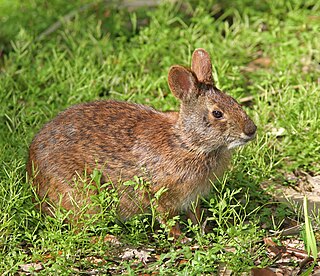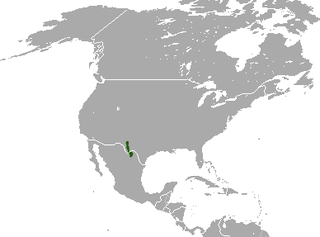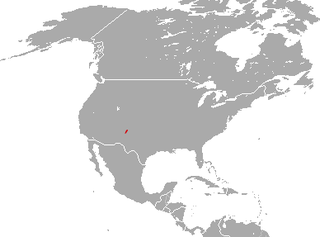| Look up cottontail in Wiktionary, the free dictionary. |
Cottontail may refer to:
| Look up cottontail in Wiktionary, the free dictionary. |
Cottontail may refer to:

The desert cottontail, also known as Audubon's cottontail, is a New World cottontail rabbit, and a member of the family Leporidae. Unlike the European rabbit, they do not form social burrow systems, but compared with some other leporids, they are extremely tolerant of other individuals in their vicinity.

The Mexican cottontail is a species of cottontail rabbit in the family Leporidae. It is endemic to Mexico where its natural habitats are temperate forests, subtropical or tropical dry forests and pastureland.

Cottontail rabbits are among the 20 lagomorph species in the genus Sylvilagus, found in the Americas. Most cottontails closely resemble the wild European rabbit. Most Sylvilagus species have stub tails with white undersides that show when they retreat, giving them their characteristic name. However, this feature is not present in all cottontails nor is it unique to the genus. For example, the European rabbit also has a white tail, and the underside of the brush rabbit's tail is blue.

Dice's cottontail is a species of cottontail rabbit in the family Leporidae. It is found in Costa Rica and Panama, in páramo and cloud forest habitats.

The Omilteme cottontail is a cottontail rabbit found only in the state of Guerrero, Mexico in the mountain range of Sierra Madre del Sur. Belonging to the family Leporidae, it is one of fourteen species in the genus Sylvilagus, a genus restricted to the New World. The Omilteme cottontail is considered one of the most endangered rabbit species in the world and is only known and been described by very few specimens.
This is a list of movies featuring recognizable dance forms, demonstrating them, shedding light on their origin, or being the base of a plot.
Peter Cottontail is a name temporarily assumed by a fictional rabbit named Peter Rabbit in the works of Thornton Burgess, an author from Springfield, Massachusetts. In 1910, when Burgess began his Old Mother West Wind series, the cast of animals included Peter Rabbit. Four years later, in The Adventures of Peter Cottontail, Peter Rabbit, unhappy at his plain-sounding name, briefly changed his name to Peter Cottontail because he felt it made him sound more important. He began putting on airs to live up to his important-sounding name, but after much teasing from his friends, soon returned to his original name, because, as he put it, "There's nothing like the old name after all." In the 26-chapter book, he takes on the new name partway through chapter 2, and returns to his "real" name, Peter Rabbit, at the end of chapter 3. Burgess continued to write about Peter Rabbit until his retirement in 1960, in over 15,000 daily syndicated newspaper stories, many of them featuring Peter Rabbit, and some of them later published as books, but "Peter Cottontail" is never mentioned again.
"Cotton Tail" is a 1940 composition by Duke Ellington. It is based on the rhythm changes from George Gershwin's "I Got Rhythm". The first Ellington recording is notable for the driving tenor saxophone solo by Ben Webster. Originally an instrumental, "Cotton Tail" later had lyrics written for it by Ellington. Later, more lyrics were written, based on the 1940 recording, by Jon Hendricks, and recorded by Lambert, Hendricks and Ross.
| This disambiguation page lists articles associated with the title Cottontail. If an internal link led you here, you may wish to change the link to point directly to the intended article. |

Rabbits are small mammals in the family Leporidae of the order Lagomorpha. Oryctolagus cuniculus includes the European rabbit species and its descendants, the world's 305 breeds of domestic rabbit. Sylvilagus includes 13 wild rabbit species, among them the 7 types of cottontail. The European rabbit, which has been introduced on every continent except Antarctica, is familiar throughout the world as a wild prey animal and as a domesticated form of livestock and pet. With its widespread effect on ecologies and cultures, the rabbit is, in many areas of the world, a part of daily life—as food, clothing, a companion, and as a source of artistic inspiration.

Leporidae is the family of rabbits and hares, containing over 60 species of extant mammals in all. The Latin word Leporidae means "those that resemble lepus" (hare). Together with the pikas, the Leporidae constitute the mammalian order Lagomorpha. Leporidae differ from pikas in that they have short, furry tails and elongated ears and hind legs.

The brush rabbit, or western brush rabbit, or Californian brush rabbit, is a species of cottontail rabbit found in western coastal regions of North America, from the Columbia River in Oregon to the southern tip of the Baja California Peninsula. Its range extends as far east as the eastern sides of the Sierra Nevada and Cascade mountain ranges

The swamp rabbit, or swamp hare, is a large cottontail rabbit found in the swamps and wetlands of the southern United States. Other common names for the swamp rabbit include marsh rabbit and cane-cutter. The species has a strong preference for wet areas, and it will take to the water and swim.

The eastern cottontail is a New World cottontail rabbit, a member of the family Leporidae. It is the most common rabbit species in North America.

The tapeti, also known as the Brazilian cottontail or forest cottontail, is a cottontail rabbit species. Its range extends from southern Mexico to northern Argentina. It is small to medium-sized with a small, dark tail, short hind feet, and short ears. The tapeti's conservation status is classified as "Least Concern" by the IUCN.

The New England cottontail, also called the gray rabbit, brush rabbit, wood hare, wood rabbit, or cooney, is a species of cottontail rabbit represented by fragmented populations in areas of New England, specifically from southern Maine to southern New York. This species bears a close resemblance to the eastern cottontail, which has been introduced in much of the New England cottontail home range. The eastern cottontail is now more common in it.

The mountain cottontail or Nuttall's cottontail is a species of mammal in the family Leporidae. It is found in Canada and the United States.

The Appalachian cottontail is a species of cottontail rabbit in the family Leporidae. It is a rare species found in the upland areas of the eastern United States. The species was only recognized as separate from the New England cottontail in 1992.

The marsh rabbit is a small cottontail rabbit found in marshes and swamps of coastal regions of the Eastern and Southern United States. It is a strong swimmer and found only near regions of water. It is similar in appearance to the eastern cottontail but is characterized by smaller ears, legs, and tail.

The robust cottontail or Davis Mountains cottontail is a species of cottontail rabbit endemic to four mountain ranges in the southwestern United States and adjacent Mexico. It was long considered to be a subspecies of the eastern cottontail, but has recently been promoted to species level due to morphological analysis. Genetic data have confirmed the uniqueness of S. robustus. S. robustus and the subspecies of S. floridanus are distinguished primarily by size, dental, and cranial differences. These rabbits typically average a total length of 42 cm, and weigh between 1.3 and 1.8 kg. This species is restricted to dry, brushy, mountains at elevations above 1500 meters. Despite its rarity, currently no governmental agency provides protection or listing for this species.

The Manzano mountain cottontail is a species of cottontail rabbit endemic to the Manzano Mountains in New Mexico, United States. It occurs in coniferous forests in high elevation. It was previously thought to be a subspecies of the Eastern cottontail.
The Suriname lowland forest cottontail is a South American species of cottontail rabbit described in 2017. It is known from the lowlands of western Suriname, and was described from specimens collected by Dutch scientists in the 1980s. Its size is relatively large for a South American cottontail rabbit. The rabbit is likely already threatened due to environmental degradation in the region, and its discovery could boost conservation efforts in the area.. It was discovered by Portland State University Professor Luis Ruedas.